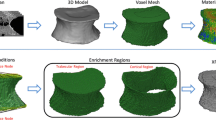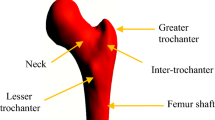Abstract
In this paper, the variations of the failure strength and pattern of human proximal femur with loading orientation were analysed using a novel quantitative computed tomography (QCT)-based linear finite element (FE) method. The QCT images of 4 fresh-frozen femurs were directly converted into voxel-based finite element models for the analyses of the failure loads and patterns. A new geometrical reference system was used for the alignment of the mechanical loads on the femoral head. A new method was used for recognition and assortment of the high-risk elements using a strain energy-based measure. The FE results were validated with the experimental results of the same specimens and the results of similar case studies reported in the literature. The validated models were used for the computational investigation of the failure loads and patterns under 15 different loading conditions. A consistent variation of the failure loads and patterns was found for the 60 different analysed cases. Finally, it was shown that the proposed procedure can be used as a reliable tool for the failure analysis of proximal femurs, e.g. identification of the relevant loading directions for specific failure patterns, or determination of the loading conditions under which the proximal femurs are failure-prone.








Similar content being viewed by others
References
Bessho M, Ohnishi I, Matsuyama J, Matsumoto T, Imai K, Nakamura K (2007) Prediction of strength and strain of the proximal femur by a CT-based finite element method. J Biomech 40(8):1745–1753
Bessho M, Ohnishi I, Matsumoto T, Ohashi S, Matsuyama J, Tobita K, Kaneko M, Nakamura K (2009) Prediction of proximal femur strength using a CT-based nonlinear finite element method: differences in predicted fracture load and site with changing load and boundary conditions. Bone 45(2):226–231
Buckley JM, Loo K, Motherway J (2007) Comparison of quantitative computed tomography-based measures in predicting vertebral compressive strength. Bone 40:767–774
Cody DD, Gross GJ, Hou FJ, Spencer HJ, Goldstein SA, Fyhrie DP (1999) Femoral strength is better predicted by finite element models than QCT and DXA. J Biomech 32(10):1013–1020
Crawford RP, Cann CE, Keaveny TM (2003) Finite element models predict in vitro vertebral body compressive strength better than quantitative computed tomography. Bone 33:744–750
Cristofolini L, Conti G, Juszczyk M, Cremonini S, Sint Jan SV, Viceconti M (2010) Structural behaviour and strain distribution of the long bones of the human lower limbs. J Biomech 43:826–835
Dall’Ara E, Pahr D, Varga P, Kainberger F, Zysset P (2012) QCT-based finite element models predict human vertebral strength in vitro significantly better than simulated DEXA. Osteoporos Int 23(2):563–572
Dragomir-Daescu D, Op Den Buijs J, McEligot S, Dai Y, Entwistle RC, Salas C, Melton LJ, Bennet KE, Khosla S, Amin S (2011) Robust QCT/FEA models of proximal femur stiffness and fracture load during a sideways fall on the hip. Ann Biomed Eng 39(2):742–755
Keyak JH, Rossi SA, Jones KA, Skinner HB (1998) Prediction of femoral fracture load using automated finite element modeling. J Biomech 31(2):125–133
Keyak JH (2000) Relationships between femoral fracture loads for two load configurations. J Biomech 33(4):499–502
Keyak JH, Skinner HB, Fleming JA (2001) Effect of force direction on femoral fracture load for two types of loading conditions. J Orthop Res 19(4):539–544
Keyak JH, Falkinstein Y (2003) Comparison of in situ and in vitro CT scan-based finite element model predictions of proximal femoral fracture load. Med Eng Phys 25(9):781–787
Keyak JH, Kaneko TS, Tehranzadeh J, Skinner HB (2005) Predicting proximal femoral strength using structural engineering models. Clin Orthop Relat Res 437:219–228
Keyak JH, Sigurdsson S, Karlsdottir G, Oskarsdottir D, Sigmarsdottir A, Zhao S, Kornak J, Harris TB, Sigurdsson G, Jonsson BY et al (2011) Male-female differences in the association between incident hip fracture and proximal femoral strength: a finite element analysis study. Bone 48(6):1239–1245
Les CM, Keyak JH, Stover SM, Taylor KT, Kaneps AJ (1994) Estimation of material properties in the equine metacarpus with use of quantitative computed tomography. J Orthop Res 12(6):822–833
Liebschner MAK, Kopperdahl DL, Rosenberg WS, Keaveny TM (2003) Finite element modeling of the human thoracolumbar spine. Spine 28:559–565
Martin JS, Marsh JL (1997) Current classification of fractures. Radiol Clin North Am 35:491–506
Mirzaei M, Zeinali A, Razmjoo A, Nazemi M (2009) On prediction of the strength levels and failure patterns of human vertebrae using quantitative computed tomography (QCT)-based finite element method. J Biomech 42:1584–1591
Mirzaei M, Samiezadeh A, Khodadadi A, Ghazavi MR (2012) Finite element prediction and experimental verification of the failure pattern of proximal femur using quantitative computed tomography images. In: Proceedings of the international conference on biomechanics and biomedical engineering, Copenhagen, Denmark, pp 111–117
Mirzaei M, Keshavarzian M, Naeini V (2014) Analysis of strength and failure pattern of human proximal femur using quantitative computed tomography (QCT)-based finite element method. Bone 64:108–114
Schileo E, Taddei F, Cristofolini L, Viceconti M (2008) Subject-specific finite element models implementing a maximum principal strain criterion are able to estimate failure risk and fracture location on human femurs tested in vitro. J Biomech 41(2):356–367
Thevenot J (2011) Biomechanical assessment of hip fracture. ACTA Universitatis Ouluensis D1128
Tintinalli JE, Stapczynski JS, Cline DM, Ma OJ, Cydulka RK, Meckler GD (2013) Classification of proximal femur fractures. Tintinalli’s emergency medicine: a comprehensive study guide, 8th Ed. http://accessemergencymedicine.com
Trabelsi N, Yosibash Z, Milgrom C (2009) Validation of subject-specific automated p-FE analysis of the proximal femur. J Biomech 42(3):234–241
Trabelsi N, Yosibash Z, Wutte C, Augat P, Eberle S (2011) Patient-specific finite element analysis of the human femur—a double-blinded biomechanical validation. J Biomech 44(9):1666–1672
Yosibash Z, Trabelsi N, Milgrom C (2007) Reliable simulations of the human proximal femur by high-order finite elements analysis validated by experimental observations. J Biomech 40:3688–3699
Acknowledgments
The authors wish to thank Dr. Mahdavi and Dr Khodadadi from the Iranian Tissue Bank (ITB, Tehran University of Medical Sciences) for providing Cadaveric samples. The QCT scans were carried out using the facilities of the Noor Clinic, with the help and support of Dr. Akhlaghpour. This research was funded and supported by Tarbiat Modares University and the INSF (Iran National Science Foundation).
Author information
Authors and Affiliations
Corresponding author
Rights and permissions
About this article
Cite this article
Mirzaei, M., Keshavarzian, M., Alavi, F. et al. QCT-based failure analysis of proximal femurs under various loading orientations. Med Biol Eng Comput 53, 477–486 (2015). https://doi.org/10.1007/s11517-015-1254-2
Received:
Accepted:
Published:
Issue Date:
DOI: https://doi.org/10.1007/s11517-015-1254-2




